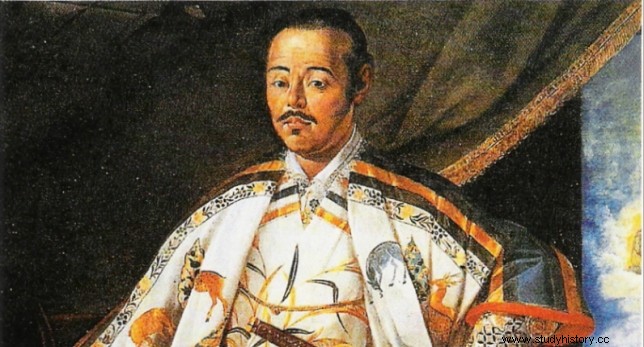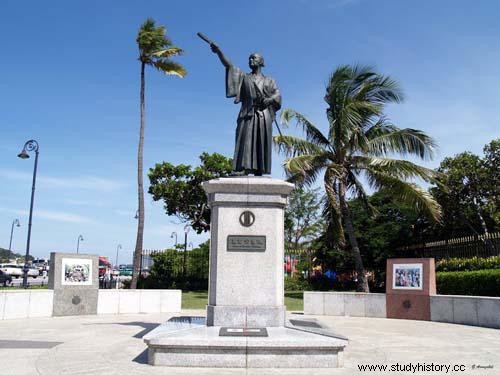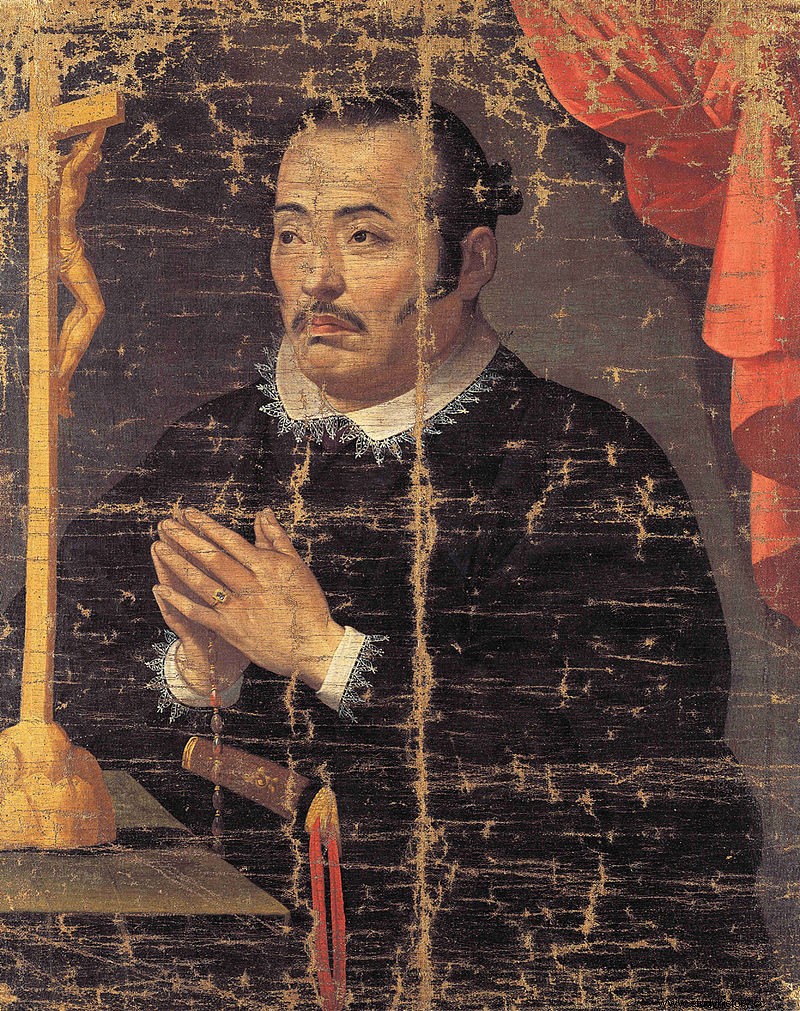Since the 16th century the Jesuits had the exclusive right to evangelize Japan, but in 1608 Pope Paul V also authorized the Dominicans and Franciscans. The Franciscan Luis Sotelo , who was in the Philippines, moved to the vicinity of Tokyo. He was too optimistic, because in that area the Christians were not very well received and he had to flee. Even so, he decided to insist and try his luck in Sendai, in the north of the island, where Christianity was, at least, tolerated. Sotelo gained the friendship of Date Masamune , Lord of Sendai, convincing him to send a diplomatic delegation to Spain and the Papal States -some sources say that he even converted to Christianity-. Masamune ordered the construction of a galleon to cross the Pacific to Mexico City (capital of the Viceroyalty of New Spain). On October 28, 1613, 180 people (samurai, merchants, sailors, servants and some Spaniards) embarked on the brand new galleon Date Mura (Saint John the Baptist For the spanish people). Leading the mission, Hasekura Rokuemon Tsunenaga , samurai and trusted man of the Lord of Sendai, accompanied by Luis Sotelo as interpreter.

After three months of travel they arrived in Acapulco, and from there to Mexico City. After leaving part of the Japanese delegation to discuss trade agreements and prepare for the return trip, they embarked for Spain. They made a stopover in Cuba -the first time a Japanese set foot on the island- and on October 5, 1614 they arrived in Sanlúcar de Barrameda (Cádiz). A few days later they left for Seville, where they will remain until the order arrives to go to Madrid for the official reception with the king. After almost two months of tourism in the area, the Japanese embassy left for the court, where they were received by King Philip III in January 1615. After complying with protocol, exchanging gifts and giving each other ears and the others to some, Hasekura gave the king a letter from his lord Date Masamune, translated by Luis Sotelo, in which he offered him a commercial treaty. And already put, they must have thought that what better sign of brotherhood than to baptize the good Hasekura. Said and done. On February 17, 1615, the Christian ceremony in which said sacrament was administered was held at the Descalzas Reales Monastery and, in addition, his name was changed to Felipe Francisco Faxicura (Felipe for the king, Francisco for his godfather the Duke of Lerma and Facixura for Hasekura's hispanicization). Although the monarch initially approved of the proposals on trade and evangelization, he decided to postpone his final response and authorized the delegation to continue its journey to the Papal States. In September they arrived in Barcelona, from where they embarked for Genoa.

Monument to Hasekura in Havana
A storm forced them to take refuge in the port of Saint-Tropez (France) where they were received by the local authorities and caused great expectation among the population due to their physical appearance and their customs...
They never touched the food with their fingers, but used two small sticks that they held with three fingers.
They blew their noses on soft tissue papers the size of a hand, which they never used twice, so they they were thrown on the ground after use, and they were happy to see our people around rushing to pick them up. Their swords cut so much that they can cut through soft paper by laying it on the edge and the wind will blow over them.

When the weather cleared, they continued their journey and reached Genoa. The triumphal entry into Rome took place on October 29 and on November 3 the public audience was held in the apostolic palace in which the Japanese were received by Pope Paul V and, again, Hasekura handed him a letter -possibly written by Luis Sotelo since it is in the Vatican and is written in Latin- in these terms…
Kissing the holy feet of the greatest, most universal and greatest saint in the entire world, Pope Paul, with submission and greatest reverence, I, Date Masamune, King of Sendai in the Empire of Japan, beg you:[…] The Franciscan Father Luis Sotelo came to our country to spread the faith of God, so I learned about this faith and wanted to become a Christian, although I have not yet been able to fulfill this desire due to certain difficulties. However, to get my subjects to become Christians, I want you to send missionaries from the Franciscan Church. For my part, I guarantee you that you will be able to build a church and that the missionaries will enjoy protection. It is also my wish that you choose and send a bishop. For this purpose I have sent my samurai Hasekura Tsunenaga Rokuyemon, as my representative to accompany Luis Sotelo across the seas on his journey to Rome, and offer you a token of obedience and kiss your feet. [...] Also, and since our country and New Spain are neighboring countries, to ask you to intervene as much as you can in the negotiation with the King of Spain; that everything will be for the benefit of sending missionaries across the seas […]

Roman citizenship title
The Pope must have shed tears of emotion. He gladly accepted the proposal and granted Hasekura the honorary title of Roman citizen. After two months in Rome, they undertook the return trip. Upon their arrival in Spain, in March 1616, they noticed that something had changed. The treatment they received had nothing to do with what they received previously. In addition, the Council of the Indies proposed that they go directly to Seville without passing through Madrid and leave in the New Spain fleet that same year. And although most of the entourage continued on to Seville, Sotelo and Hasekura still remained in court for a few days, claiming that they were waiting for the monarch's response. Faced with pressure from the Council of the Indies and the Casa de la Contratación, they left Madrid and went to Seville to meet up with the rest of the entourage. Claiming to be sick, Sotelo and Hasekura managed to stay a few more months in Seville (specifically in the towns of Espartinas and Coria del Río), but the answer would never come... Since they began their trip, things in Japan had changed a lot, it had spread throughout throughout the country a wave of violence and terror against Christians, and before these new conditions the monarch did not sign any agreement. Without economic means and diplomatic resources exhausted, on July 4, 1617, the Japanese embassy left Seville. They arrived in Mexico at the beginning of February 1618 and in the month of May they went to Acapulco from where they left in the San Juan Bautista to arrive in Manila in early July. Hasekura would not return to Japan until 1620, where he lost track of her. Later, it was discovered that he died just two years later, perhaps martyred. For his part, the Franciscan Sotelo did not return to Japan until 1622, and he did so on a Chinese ship disguised as a merchant. He was seized and later burned alive at Omura, near Nagasaki on August 25, 1624.
The struggles between the different missionary orders and the persecution of Christians in Japan demolished that embassy that had toured Europe for almost four years. But not all of them left... a small group of Japanese decided to stay in Seville and its surroundings -logical when knowing how well people lived there-. Today, their descendants continue to use the surname Japan .

Monument to Hasekura in Coria del Río
